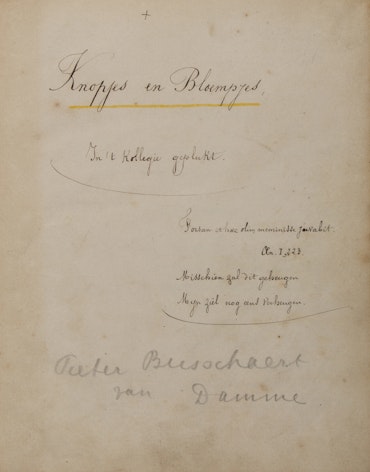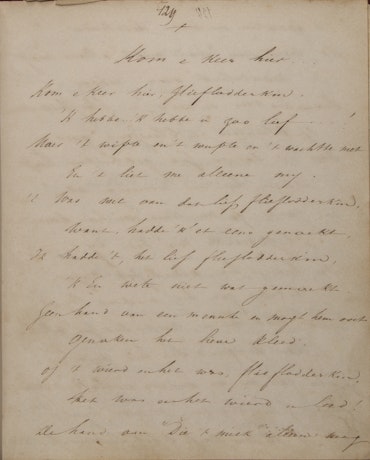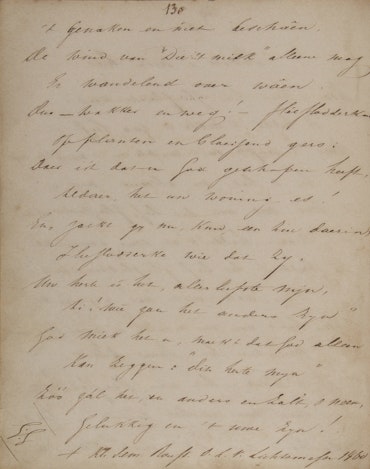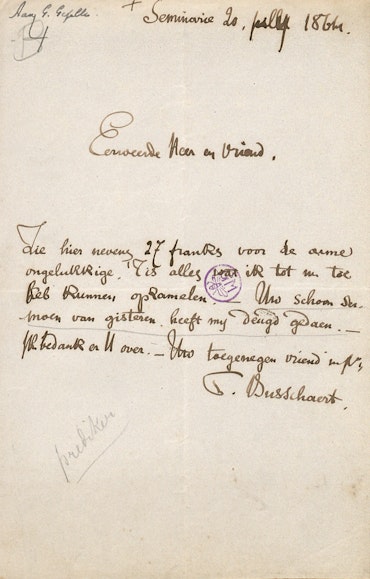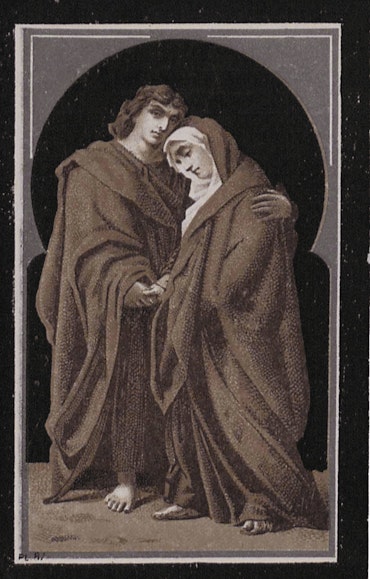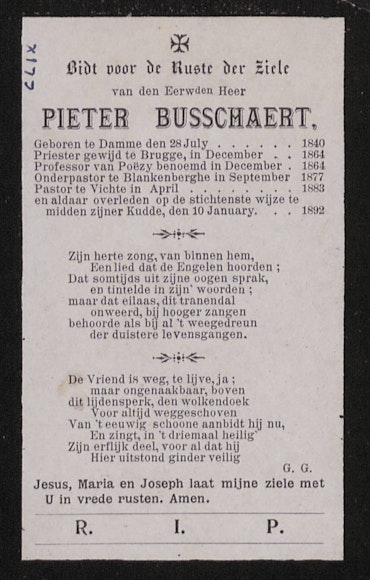

Themes
Pieter Busschaert
Damme 28.07.1840 - Vichte 10.01.1892
Pieter Busschaert was the son of Ludovicus Busschaert, baker, and Sabina Vankerschaver. He attended secondary school at the Saint Louis college in Bruges, where L. L. De Bo was one of his teachers. He collected his verses in a school exercise book, using the title Knopjes en Bloempjes in ‘t College geplukt (Buds and Flowers picked at the college). In 1859 Busschaert started priest training at the minor seminary in Roeselare, where Guido Gezelle was a teacher. He remained friends with Gezelle all his life. The poem Kom e keer hier flieflodderke which Gezelle wrote in 1860, was dedicated to “Pieter Busschaert van Damme”. Gezelle later on also appealed to his musical knowledge. In the margins of his poem “O Maria, die daar staat” he mentioned “Zangwijze Pieter Busschaert” (Tune Pieter Busschaert). During his studies at the major seminary in Bruges, he directed the Schola Cantorum. He also composed a Stabat Mater which was sung each year at the Holy Blood procession. In spite of this he was not to study music, which was one of Busschaert’s frustrations, according to the article by Edgar Tinel in Musica Sacra. As a self-taught composer he did copy several masses by the sixteenth-century composer Giovanni Pierluigi da Palestrina in order to familiarize himself with his composition style. Later on he was introduced to the oeuvre of Bach, Haydn, Beethoven, Schumann and Brahms. On December 17th, 1864 Busschaert was ordained priest, on the same day as Hugo Verriest. Soon afterwards both were appointed teacher at the Saint Louis college in Bruges. Pieter Busschaert was entrusted with the fifth form and taught music classes to interested pupils, including Karel Mestdagh. In 1877 Busschaert became curate in Blankenberge, where he regularly met Edgar Tinel and Marie Belpaire. In 1883 he became parish priest in Vichte. His musical knowledge was extremely valued in these places. Busschaert was a close friend of the principal of the Brussels conservatory F. Gevaert and consequently often served as a jury member during organ competitions at the conservatory. He also was a frequent member of the jury at the final exam of the “Ecole de musique religieuse” in Mechelen. Music during church services was important to Busschaert, which manifests in his search for benefactors to replace the old organ at the church in Vichte. On March 12 1891 that day finally arrived: the new instrument was played for the first time by Alphonse Mailly. However, Busschaert was not able to enjoy it for long. He died in his parsonage on January 10th, 1892, aged 52. He composed music for texts by Guido Gezelle, such as Bedevaartlied ter eere van O.L. Vrouw van ruste, O Blijde maand!, O Maria die daar staat, O Maria onbevlekte, Jesu allerliefste kind, O Eene uit al, O Moeder Gods, Feestlied, Te lande en langs de dreven. Apart from the music that Busschaert wrote for these numerous poems, he mainly wrote vocal religious music.
Online Edition of the Gezelle Letters
Here you can find the digitized letters next to the full searchable text. The letters are enriched with biographical and contextual information.

